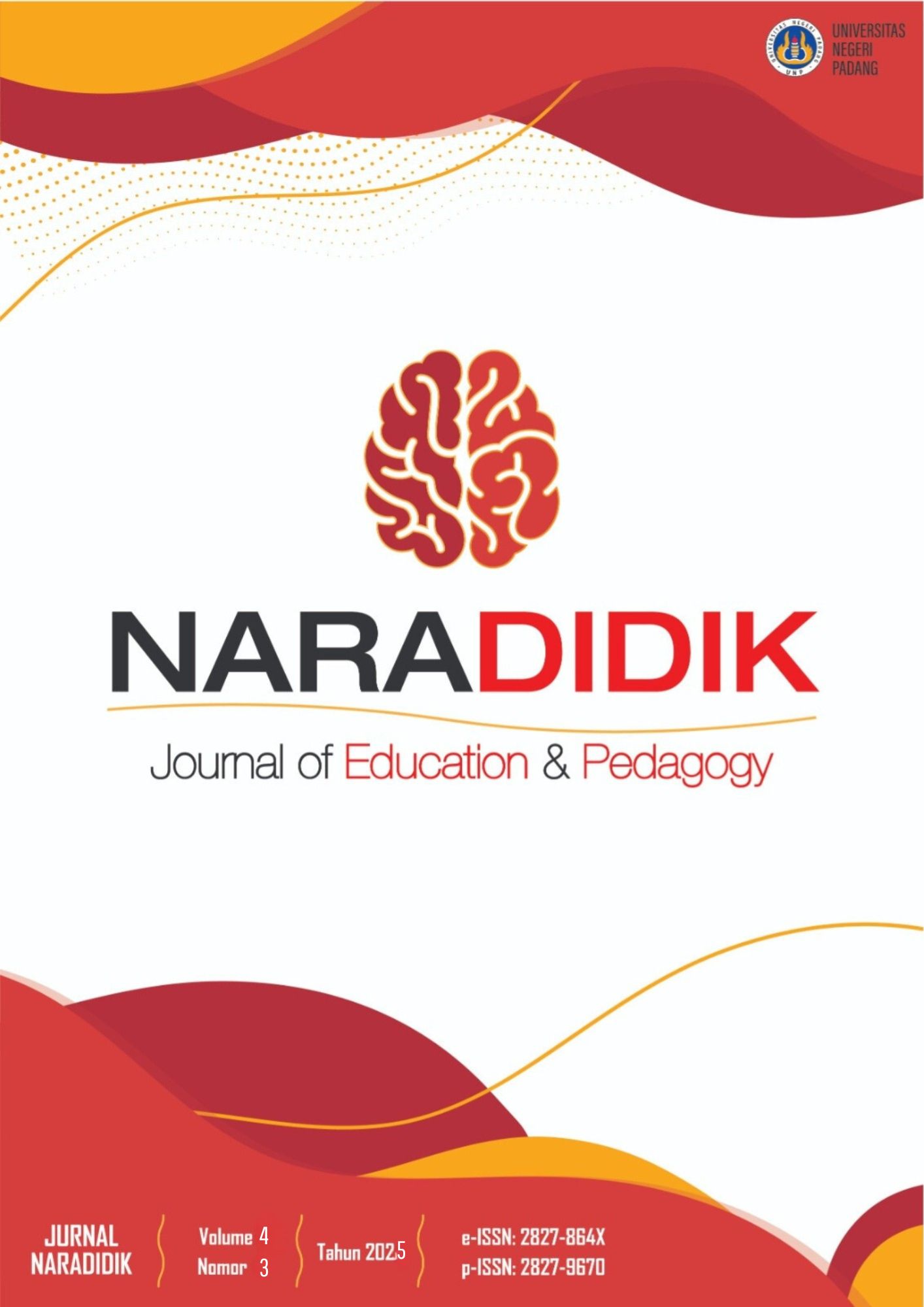Merakit Keterampilan Abad ke-21 Melalui Teaching Factory dengan Model Discrepancy
DOI:
https://doi.org/10.24036/nara.v4i3.366Keywords:
Discrepancy Evaluation Model, Pendidikan Vokasi, Teaching FactoryAbstract
Peningkatan soft skills menjadi salah satu prioritas dalam pendidikan vokasi abad ke-21, mengingat dunia kerja menuntut lulusan yang tidak hanya kompeten secara teknis, tetapi juga adaptif, komunikatif, dan kolaboratif. Teaching Factory sebagai model pembelajaran berbasis produksi nyata dipandang mampu menjembatani kesenjangan antara kompetensi sekolah dan kebutuhan industri. Namun, implementasinya di banyak sekolah menengah kejuruan (SMK) masih menghadapi tantangan seperti kurangnya integrasi evaluasi soft skills, keterbatasan pelatihan guru berbasis industri, serta lemahnya sistem refleksi program. Penelitian ini bertujuan mengevaluasi pelaksanaan Teaching Factory di sebuah SMK swasta menggunakan pendekatan Discrepancy Evaluation Model (DEM) untuk mengidentifikasi kesenjangan antara tujuan dan praktik di lapangan. Metode yang digunakan adalah kualitatif deskriptif dengan beberapa informan yang dipilih melalui teknik purposive sampling, terdiri dari kepala sekolah, 4 guru produktif, dan 5 siswa yang terlibat langsung dalam program. Data dikumpulkan melalui wawancara mendalam, observasi partisipatif terhadap proses pembelajaran di bengkel kerja dan interaksi dengan mitra industri, serta analisis dokumen perencanaan dan evaluasi. Validasi dilakukan melalui triangulation of sources dan member checking. Analisis data dilakukan secara tematik mengacu pada lima komponen DEM: standar, kinerja, analisis kesenjangan, penyebab kesenjangan, dan strategi perbaikan. Hasil penelitian menunjukkan bahwa Teaching Factory berkontribusi pada penguatan komunikasi, kerja tim, dan tanggung jawab siswa, namun masih terdapat kelemahan pada perencanaan, konsistensi pembimbingan guru, dan evaluasi soft skills. Rekomendasi meliputi penguatan desain program, pelatihan guru berbasis industri, dan integrasi evaluasi berkelanjutan.
References
Bakhtiar, R. (2024). Effectiveness of using Teaching Factory to improve professional competence of teachers in state vocational schools in Jakarta. zhttps://www.preprints.org/manuscript/202408.0916
Brown, A., & Green, T. (2022). Digital portfolios as authentic assessment tools in vocational education. International Journal of Vocational Education and Training, 30(3), 201–218. https://doi.org/10.xxxx/ijvet.2022.30.3.201
Bulkani, B., Setiawan, M. A., & Wahidah, W. (2022). The discrepancy evaluation model in the implementation of online learning on the basis of parents' perceptions. The Education and Science Journal, 24(2), 116–137. https://doi.org/10.17853/1994-5639-2022-2-116-137
Chryssolouris, G., Mavrikios, D., & Rentzos, L. (2016). The Teaching Factory: A manufacturing education paradigm. Procedia CIRP, 57, 44–48. https://doi.org/10.1016/j.procir.2016.11.009
Creswell, J. W., & Poth, C. N. (2018). Qualitative inquiry and research design: Choosing among five approaches (4th ed.). SAGE Publications.
Fathudin, S., Widodo, A., Harjanto, C. T., Prasetya, T. A., & Ma’ruf, K. (2024). Development of innovative model soft skills in vocational higher education case study in Republic of Indonesia. Community Practitioner, 21(5), 1397. https://doi.org/10.5281/zenodo.11365271
Guest, G., Namey, E., & Mitchell, M. (2013). Collecting qualitative data: A field manual for applied research. SAGE Publications.
Harrison, C., & Walters, K. (2023). Reflective practice in vocational education: Strategies for continuous improvement. Journal of Workplace Learning, 35(5), 421–438. https://doi.org/10.xxxx/jwl.2023.35.5.421
Johnson, M., & Keating, J. (2021). Sustaining industry partnerships in vocational training: Infrastructure and skills development. Journal of Technical Education and Training, 13(4), 45–59. https://doi.org/10.xxxx/jtet.2021.13.4.45
Kusuma, H. (2024). The readiness of implementation Teaching Factory. Journal of Engineering Science and Technology, Special Issue ISCoE 2024_2, 14, 112–118.
Lee, H., Park, S., & Kim, J. (2023). Formative assessment of soft skills in vocational training environments. International Journal of Training Research, 21(1), 67–83. https://doi.org/10.xxxx/ijtr.2023.21.1.67
Lincoln, Y. S., & Guba, E. G. (1985). Naturalistic inquiry. SAGE Publications.
Martawijaya, R. (2012). Teaching Factory sebagai model pembelajaran produksi dan bisnis di SMK. Jurnal Pendidikan Vokasi, 2(2), 234–245. https://doi.org/10.21831/jpv.v2i2.1032
Mertens, D. M., & Wilson, A. T. (2019). Program evaluation theory and practice: A comprehensive guide (2nd ed.). Guilford Press.
Miles, M. B., Huberman, A. M., & Saldaña, J. (2014). Qualitative data analysis: A methods sourcebook (3rd ed.). SAGE Publications.
Nowell, L. S., Norris, J. M., White, D. E., & Moules, N. J. (2017). Thematic analysis: Striving to meet the trustworthiness criteria. International Journal of Qualitative Methods, 16(1), 1–13. https://doi.org/10.1177/1609406917733847
Oviawe, J. I. (2020). Enhancing development of soft skills among technical vocational education and training students towards achieving the Sustainable Development Goals. Socialsci Journal, 6(1).
Patton, M. Q. (2015). Qualitative research & evaluation methods: Integrating theory and practice (4th ed.). SAGE Publications.
Saputro, I. N., Soenarto, S., Sofyan, H., Riyanita, M. C., Rebia, P. S., & Listiana, A. (2021). The effectiveness of Teaching Factory implementation in vocational education: Case studies in Indonesia. Universal Journal of Educational Research, 9(11), 1841–1856. https://doi.org/10.13189/ujer.2021.091104
Sari, D. P., & Nugroho, A. (2025). Evaluating the impact of the Teaching Factory model on vocational students’ employability skills. BIO Web of Conferences, 45, 04015. https://doi.org/10.1051/bioconf/20254504015
Schallock, B., Rybski, C., Jochem, R., & Kohl, H. (2018). Learning Factory for Industry 4.0 to provide future skills beyond technical training. Procedia Manufacturing, 23, 31–36. https://doi.org/10.1016/j.promfg.2018.03.155
Setiawan, M. A., & Bulkani, B. (2022). Implementation of discrepancy evaluation application based on parents' perceptions. TEM Journal, 11(4), 2613–2624. https://doi.org/10.18421/TEM114-36
Shenton, A. K. (2004). Strategies for ensuring trustworthiness in qualitative research projects. Education for Information, 22(2), 63–75. https://doi.org/10.3233/EFI-2004-22201
Smith, L., & Galvin, R. (2022). Setting measurable learning objectives for soft skills in vocational education. Education and Training, 64(6), 789–805. https://doi.org/10.xxxx/et.2022.64.6.789
Subekti, M., & Suryadi, D. (2019). Work-based learning–Teaching Factory in Indonesia as a model to link and match vocational education and industry. TVET@Asia, (13), 1–15.
Supriyadi, T., & Yusuf, M. (2023). Modification of CSE-UCLA and discrepancy as a new evaluation model in vocational education. European Scientific Journal, 19(10), 45–58. https://doi.org/10.19044/esj.2023.v19n10p45
Sutrisno, H., & Wibowo, A. (2023). Teaching Factory management on vocational high school: Case study. Scientific and Applied Research Journal, 7(1), 29–35. https://doi.org/10.18421/SAR71-05
Wahjusaputri, S., Nastiti, T., & Sukmawati, R. (2024). Development of Teaching Factory model-based artificial intelligence improving the quality of learning vocational schools in Indonesia. Al-Ishlah: Jurnal Pendidikan, 16(1), 112–125. https://doi.org/10.35445/alishlah.v16i1.5979
Wahyudin, D., Hanafi, I., & Ahmad, M. (2024). Enhancing vocational education through the Teaching Factory model: Focusing on the collaboration between industry and educational institutions. Edelweiss Applied Science and Technology, 9(2), 1747–1758. https://doi.org/10.55214/25768484.v9i2.4904
Widodo, A., & Fathudin, S. (2024). Enhancing vocational education through the Teaching Factory model. Edelweiss Applied Science and Technology, 9(2), 1747–1758. https://doi.org/10.55214/25768484.v9i2.4904
Yusuf, M., & Supriyadi, T. (2020). Evaluation of implementation of Teaching Factory programs in state vocational high schools in Indonesia. International Journal of Education and Research, 8(1), 123–134.
Downloads
Published
How to Cite
Issue
Section
License
Copyright (c) 2025 Author

This work is licensed under a Creative Commons Attribution-ShareAlike 4.0 International License.








.png)












